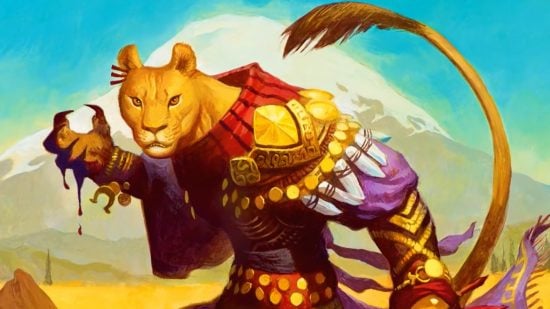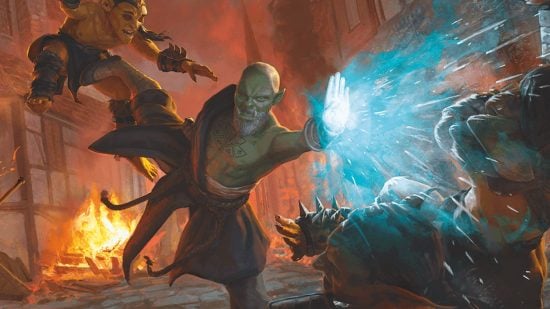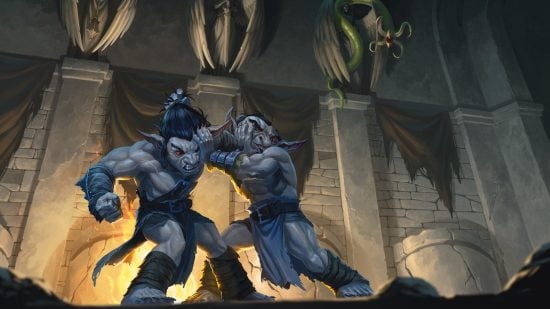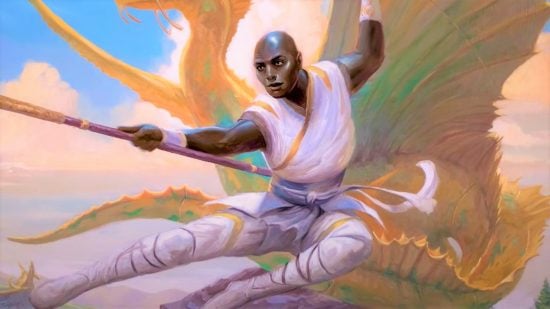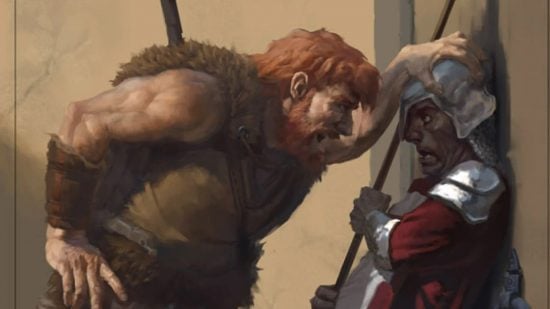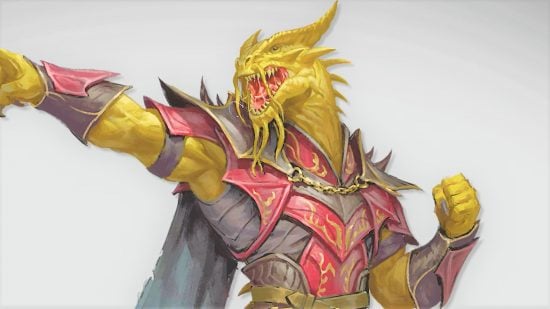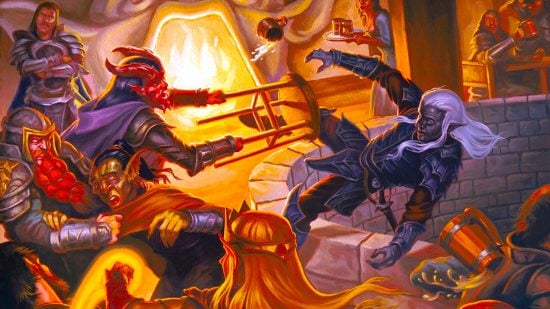The Unarmed Strike 5e rules sound like they should be simple, but the truth is far stranger. Simply punching, kicking, or headbutting an enemy requires a surprising amount of reading to make sure you’ve got your rules right. For every improvised attacker out there, we’ve done the hard work for you – here are all the key DnD unarmed strike rules you need to know.
We’ve covered the rules as written in the core DnD books, as well as how those rules interact with different DnD classes, DnD races, 5e feats, and DnD magic items. Any basic questions you have about hitting, we can answer.
Standard rules for unarmed strike 5e
According to the DnD 5e Player’s Handbook: “Instead of using a weapon to make a melee weapon attack, you can use an unarmed strike: a punch, kick, head-butt, or similar forceful blow (none of which count as weapons). On a hit, an unarmed strike deals bludgeoning damage equal to 1 + your Strength modifier. You are proficient with your unarmed strikes.”
This seems simple, but there are a few things to unpack here. Firstly, you’re always proficient with unarmed strikes, so you’ll add your Strength modifier and proficiency bonus to attack rolls (unless you’re a DnD Monk, but more on that later).
Secondly, in ordinary circumstances, your character’s body does not count as a DnD weapon – even if unarmed strikes are considered melee weapon attacks. This means an unarmed strike (whatever body part you’re using) doesn’t synergize with a lot of character features in Dungeons and Dragons.
For example, a DnD Paladin can’t use Divine Smite if they land an unarmed strike, as they need to be using a weapon. Also, you can’t typically use your bonus action to make a second attack as per the rules of two-weapon fighting, as you need to be using a weapon with the ‘light’ property.
Next, there’s no damage die to roll on a successful hit with an unarmed strike. This means you can never land a critical hit with a standard unarmed strike. It also means it’s possible to deal zero damage – if your Strength modifier is -1, throwing a punch will probably never be worth it.
Unarmed strike 5e rules for different DnD classes
DnD Monk
The one DnD class that’s designed to use unarmed strikes is the Monk. As a Monk, you can use your Dexterity modifier instead of Strength for unarmed strike attacks, and you can make a second unarmed strike as a bonus action – even if your first attack was with a Monk weapon rather than a part of your body. Hell, if you use the Flurry of Blows feature, you can spend a Ki point to make two unarmed strikes as a bonus action.
Plus, you roll 1d4 instead of dealing the base damage. This damage die grows larger as you go from DnD level up to level up, eventually maxing out at 1d10. Advance far enough, and your unarmed strikes eventually become magical, too.
DnD Barbarian
One of the DnD Barbarian subclasses has its own version of unarmed strikes – the Path of the Beast. This Barbarian 5e transforms into a beast when they rage, and they can choose to manifest one of three simple melee weapons:
| Weapon | Damage type | Damage die |
| Bite | Piercing | 1d8 |
| Claws | Slashing | 1d6 |
| Tail | Piercing | 1d8 |
These attacks each come with their own unique bonus, but they also count as melee weapons. This means, unlike a standard unarmed strike, they’ll synergize with any rule that requires you to hit with a weapon.
Unarmed strike 5e rules for DnD races
Several DnD races have unique features which alter the standard rules for unarmed strikes. Most of these features (especially since the release of Monsters of the Multiverse) change the damage type dealt by unarmed strikes and allocate a damage die rather than the usual set damage.
Here are the DnD races that can make more powerful unarmed strikes:
| Name | Unarmed attack name | Damage type | Damage die |
| Aarakocra | Talons | Slashing | 1d6 + Strength modifier |
| Centaur | Hooves | Bludgeoning | 1d6 + Strength modifier |
| Leonin 5e | Claws | Slashing | 1d4 + Strength modifier |
| Lizardfolk | Bite | Slashing | 1d6 + Strength modifier |
| Minotaur | Horns | Piercing | 1d6 + Strength modifier |
| Satyr | Ram | Bludgeoning | 1d6 + Strength modifier |
| Tabaxi 5e | Claws | Slashing | 1d6 + Strength modifier |
| Tortle 5e | Claws | Slashing | 1d6 + Strength modifier |
It’s also written that the Loxodon can use their trunk to make an unarmed strike, but they don’t use any exceptional rules to do so.
Other rules that interact with unarmed strikes
Feats
There’s only really one 5e feat that shakes things up when it comes to unarmed strikes. Tavern Brawler lets you deal 1d4 damage with your unarmed strikes, and you can choose to use grapple 5e as a bonus action after a successful hit.
Given how many races can deal better damage and the synergy the Monk class already has with unarmed strikes, this isn’t a particularly popular feat (unless you’re playing Baldur’s Gate 3, where it has a lot more utility).
Magic items
There is a range of DnD magic items designed to enhance unarmed strikes. These include:
- Wraps of Dyamak – adds increasing attacks and damage bonuses to unarmed strike
- Wyrmreaver Gauntlets – adds 1d6 force damage and 30 feet of reach to unarmed strikes
- Eldritch Claw Tattoo – adds a +1 bonus to unarmed strike attack and damage rolls, and can add 15 feet of reach and an extra 1d6 force damage to attacks
- Gloves of Soul Catching – Unarmed strikes deal an extra 2d10 force damage, and you regain this number of hit points or advantage on a roll of your choice
- Cape of Enlargement – Adds your proficiency bonus to unarmed strike damage
For more on how to play Dungeons and Dragons, check out our guides to DnD backgrounds and 5e spells.
